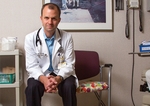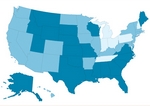government
Final Medicare no-pay rule targets 10 hospital-acquired conditions
■ Physicians had called for the reform to include only condition categories that can be eliminated through evidence-based practices.
- WITH THIS STORY:
- » The no-pay list
- » Hospitals to have more measures to report
Washington -- A new effort to reduce hospital Medicare pay for preventable medical complications won't result in a significant number of rejected claims, according to federal officials. But physicians insisted the initiative needs to be reworked to account for patient risk factors and other issues largely beyond doctors' control.
The Centers for Medicare & Medicaid Services on July 31 finalized a rule that lists 10 categories of hospital-acquired conditions for which it will limit inpatient Medicare payment starting Oct. 1. The list includes two additional categories of conditions from a previously proposed list of eight and an expansion of a proposed surgical infection category. If patients develop any of these medical problems during their hospital stays, Medicare will not reimburse the hospital at the higher rate for treating these complications. It will still pay to treat the primary diagnosis and other complications. The rule does not alter payment for the physicians who provide that care.
CMS estimates the effort will reduce Medicare spending by only about $21 million per year. In contrast, the program spent about $20 billion last year on total care for patients with these problems. That's in part because patients often have complications that are not listed in the rule and thus do trigger higher Medicare payments.
CMS Acting Administrator Kerry Weems downplayed the dollars at stake and said the pay reforms have a larger goal than reducing spending.
"This is really about making hospitals and the health system just a safer place to be," Weems said. The rule also applies to private Medicare plans.
Doctors agreed that some of the listed conditions, such as a foreign object inside a surgery patient, should be prevented all of the time. But CMS should not apply the same rules to conditions that doctors cannot always prevent, such as surgical infections, said American Medical Association President-elect J. James Rohack, MD.
"To be reasonably preventable, there should be solid evidence that by following guidelines, the occurrence of an event can be reduced to zero or near zero," he said. "This is not the case for many of the now-banned conditions."
The CMS effort will actually increase spending on tests to determine whether patients have the conditions, which could negate some of the savings CMS anticipates, Dr. Rohack said. "A more effective patient safety approach would be to encourage compliance with evidence-based guidelines by health care professionals."
Conditions omitted, for now
CMS had proposed including up to 17 condition categories with 22 individual items in the final rule. Public comments critical of the rule convinced the agency to exclude many of them, officials said.
"We had a lot of robust discussion in the comments concerning the hospital-acquired conditions. We responded ... by removing some of those for reconsideration," said Jeffrey Rich, MD, director of CMS' Center for Medicare Management.
Two of the more controversial conditions CMS proposed but did not include in the rule were ventilator-associated pneumonia and Clostridium difficile-associated disease, Dr. Rich said. The conditions cost Medicare a combined $10 billion to treat last year. The AMA and other organizations objected to their inclusion because they were not "reasonably preventable," as required by the Deficit Reduction Act of 2005. That law instructed CMS to limit payment for avoidable hospital-acquired conditions.
CMS will continue to work with the Agency for Healthcare Research and Quality and the National Quality Forum to develop evidence-based guidelines in advance of including these and other omitted conditions in future Medicare no-pay rules, Dr. Rich said. "We think these are very serious infections that are important to the health care system and to the patients of the United States. So we will continue to look at these."
The rule does not address payment for errors involving physicians performing the wrong surgery or operating on the wrong patient or body part. CMS will finalize these policies by April 2009.
CMS also has plans to expand the hospital-acquired conditions payment policy outside of the inpatient setting. The agency eventually anticipates applying this rule to nursing homes, home health agencies and ambulatory care settings, said CMS Chief Medical Officer Barry Straube, MD. But a spokesman said the agency would need approval from Congress before subjecting physician practices to the same policy.
The risk factor
The rule could lead physicians and hospitals to be wary about treating higher-risk beneficiaries, doctors said. Every patient has the same risk for having a foreign object left inside him or her, but not everyone has the same risk for a pulmonary embolism, said Kevin J. Bozic, MD, an American Academy of Orthopaedic Surgeons board member. Patients who have had a previous embolism or who are morbidly obese are more likely to have one, but the CMS rule excludes payment for embolisms related to knee and hip replacements without recognizing this risk.
"You need to appropriately factor in the patient risk when determining whether a condition is reasonably avoidable," Dr. Bozic said.
Every no-pay condition must also have evidence-based prevention standards for physicians to follow, said Nancy Foster, the American Hospital Assn.'s vice president for quality and patient safety. Even straightforward-sounding complications such as falls are difficult to eliminate because there are no evidence-based guidelines to accomplish that, she said.
"It's like wishing you could cure cancer or heart disease. It won't happen just because you change the payment system," Foster said.
Hospital administrative staff will rely on physicians' notes to determine whether patients had any conditions when they were admitted, Dr. Bozic said. That means doctors will need to spend more time documenting existing infections and signs of pressure ulcers on incoming patients.
The rule should allow for a third-party review of the events that led to the condition to see if it was a truly preventable occurrence, said Bruce Auerbach, MD, a member of the American College of Emergency Physicians' Quality and Performance Committee. "It's not always as clear-cut as the rules appear to indicate."
Still, the rule could have included more conditions and increased doctors' workload even more dramatically, Dr. Auerbach said. "Overall, people are somewhat reassured by the fact that the list was not larger."












